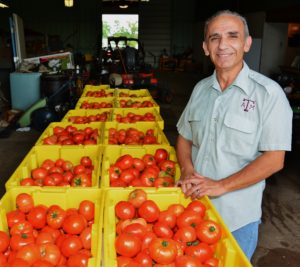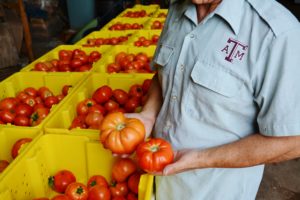AgriLife Extension expert: Grow tomatoes all season long
- Writer: Adam Russell, 903-834-6191, adam.russell@ag.tamu.edu
- Contact: Dr. Joe Masabni, 903-834-6191, joe.masabni@ag.tamu.edu
OVERTON – Timing and variety choice can help tomato aficionados avoid production gaps during the dog days of summer, according to a Texas A&M AgriLife Extension Service expert.
Texas gardeners typically plant tomatoes twice – in the spring and late-summer – with a break during extremely hot periods of July and August, during which production usually slows or stops, according to Dr. Joe Masabni, AgriLife Extension horticulturist, Overton.
But multiple plantings and choosing the right varieties can give growers a chance to bridge the gap to fall production and ensure tomatoes are always on the table.
“Tomatoes are tomatoes,” Masabni said. “They can grow between the last spring frost to the first freeze in fall or early winter. You can harvest throughout the season if you plant more than twice a year.”
Traditionally, Masabni said, growers plant in the spring for summer harvest. They pull the plants in July as fruit production slows or stops. A second planting in late-August or early September allows plants to avoid harsh summer conditions and produce until the first winter freeze.
Planting three or four times, however, and timing the plantings correctly will ensure season-long harvest, he said.
Tomato seeds take four weeks to become seedlings, he said. It takes another eight to 10 weeks for those plants to begin producing with a four week harvest.
“That means 12-15 weeks from seed to first harvest, and you want your second planting to begin producing around the time your first planting has passed peak production,” Masabni said. “So, five to six weeks after planting, you’ll want to seed again in order to have that second round of plants ready to plant by mid-June. Then five to six weeks, seed again, and then again.”

Masabni said timing may vary by location, and growers in North Texas or the Panhandle may want to consider short-season tomato varieties that produce in 45 days compared to 60 days for the final planting to avoid historically earlier killing frosts in the fall.
Variety choices are important for the middle plantings, Masabni said. Follow typical spring varieties with heat-tolerant varieties.
He recommends Mountain Spring for the early June planting and Heatwave, Sunmaster, Solar Fire or Solar Set for the late-June/July planting.
“Those varieties should get you to the fall planting,” he said.
To be safe, Masabni recommends gardeners divide the tomato planting areas into four sections and use each section for each different planting. This can help avoid nematodes or diseases getting established in the garden. Other non-family plants such as okra, squash or cowpeas can follow tomatoes.
Growers may also want to pay closer attention to insect or disease pressures in their June or July plantings because problematic bugs and diseases become more prevalent as the season progresses, he said.
“Other than that, just follow your typical fertilizer, water, fungicide and insecticide regimens, and you will have tomatoes all season,” he said.
For more details about AgriLife Extension recommendations for tomatoes and other vegetables, go to https://aggie-horticulture.tamu.edu/.



